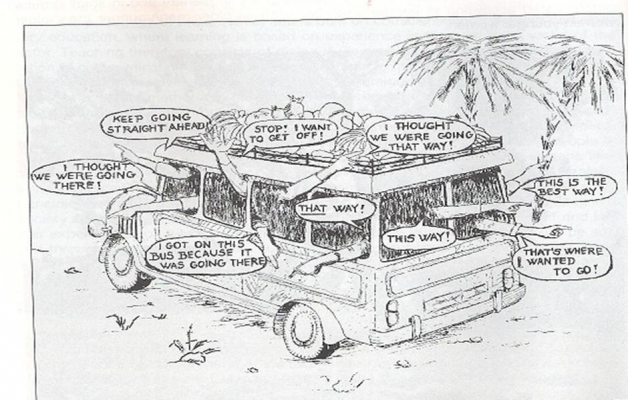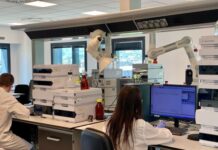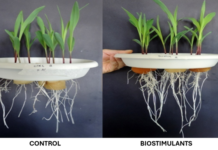
A community without a collective revelation will not grow or make progress in life (see picture above).
By Innocent Mhangarai
Resilience building efforts in communities have borne tangible results as this has schooled them to value physical assets like boreholes, weir dams and productive tools at the expense of invisible assets like knowledge on how to realize value from those assets. In communities where assets like boreholes, productive tools, weir dams, nutrition gardens, irrigation schemes and road networks have been constructed or rehabilitated, households are still apprehensive on how they can crack value from those assets in the absence of a market for commodities as they have to be produced and transported to consumption areas like growth points, towns and also cities.
Through documentation of such gaps, this is where the ability to evaluate predominant knowledge or invisible assets becomes imperious. Imperative to note is the fact that every community has intangible valuable belongings that come in the form of knowledge, engrossments, enthusiasms, dreams and craving for risk and this has been passed from one generation to another over years. However, such assets are hard to measure and attach value. On the other hand, connections from the development community dawdles to afford subsidy in the form of physical hardware as contradictory to software issues like evidence which can turn belongings into better livelihoods. Implications of overseeing invisible properties are often evident in the form of under-utilization of these community assets like boreholes, weir dams, irrigation equipment, expensive processing equipment, productive tools, raw materials as well as roads. If communities are vested with formularies for appraising the value of their proficiency on using skill, land, pastures, collection of non-timber forest products and make use of road networks, they can be able to see how such assets are saving a resolution. For example, the value of good road networks can be measured through high quality supplies that are transported to the market from the community. Therefore, gathering such details means investing a lot in data gathering.
Data gathering
It is through data gathering and analysis that communities can be well-versed to transform on the basis of accessible resources in their vicinities such as land, water as well as pastures. Data gathering on the major happenings in a community whether on-farm or off-farm makes it conceivable to see the worth of the road networks amongst others factors. Notwithstanding the fact some may think this is a hard-hitting procedure, actors in any community have facts and tools that can easily be combined to provide all-inclusive picture for the entire common people. Nevertheless, unless there is agreement on what needs to be measured and understood, the drive of gathering the data is misplaced. Community associates have to come to an agreement and effort their data gathering vision of what they want to realize. This will be the groundwork on which community data-driven physiques can be constructed. In due course, data will prompt to inspire local business and social results in ways that bring into line all actors doing similar activities. Whereas some data is in people’s heads, devices of gathering it can be set up so that gathering becomes a fluid procedure.
Providing an organized data gathering method can guarantee cleanliness of the data in ways that simplifies usage. Communities can recognize people accountable for cleaning and certifying reliability in the quality and readiness of data. In addition to safeguarding data is accessible when essential, it is also fundamental to determine different onlookers for diverse data sets. Decision makers need incongruent data from that needed by those in the community. Local businesses like hardware’s, agro-dealers and general dealers may be more absorbed in business metrics than general acumens. Taking note of that, development interventions having provided hardware like infrastructure it is time they move to supporting the germination and application of software like information and the right attitudes to communities. This means investing a lot into training for transformation to community animators who will cascade the information to the communities.
Informing training for transformation
The training for transformation method is meant to kindle people’s active participation to take accountability of their own lives. It vests them to analyse causes of problems, challenge forms of prejudice and plan action to address the status quo. Dialogue with communities is thus a realistic requirement. Communities are characterized with personalities with varied backgrounds as well as levels of numeracy and literacy, hence there is need to put them together in order to discuss issues on the ground and reach compromise.
Providing communities with exposure to platforms that educate them to realise their belongings will make take responsibility and attach value to their available resources. In most cases communities will seek external help not realising the value of assets they possess in their localities, for example a community with weir dams has potential of making their local economy liquefied as they can tap into the availability of water as a resource in the community and produce high value horticultural crops among other product. The training for transformation works well through preliminary engagement with community animators who will then cascade the knowledge to community level. Such interventions triggers community development, therefore it is imperative to educate communities to value their resources and make them avenues to generate income for livelihood. Having invested on training for transformation, communities can unleash their potential through harnessing their resources and technology to know happenings around them and also to make themselves known to their outside environment.
The power of technology and communication patterns
The dimension of communication is growing, not just by phone calls and messages but through internet-based communication models which are more distinct. Social networking media such as whatsapp and facebook are progressively moulding the communication culture especially during the lockdown which came as a result of the occurrence of the COVID-19 pandemic. The challenge is not just in understanding the technology, but also the relating essential shifts in human social and communication behavior, and how business is steered in this setting. Technology is defining new culture in community development it has improved means of communication in community health projects and also humanitarian responses. Through technology development, mass communication is no longer one-way but two-way and more interactive with wider onlookers than before. The new technology is enabling audiences to speak and participate on various platforms.
Communities can tap into such opportunities and make use of technology for estimation and early warning systems for example knowledge about the coming of Cyclone Chalane a few weeks back and also marketing of their products. This assists local traders and farmers in gathering valued perceptions on the behaviour of different commodity buyers, instead of banking on middlemen who often divert business outcomes in their favour. Favourable pricing of commodities can also be enabled through consistent flow of information about commodity volumes and prices in varied markets. Receiving the right data in the right place at the right time is the first step in establishing vigorous commercial competences for farmers and agribusinesses that are struggling to find their place in the market. Better and more knowledgeable decisions can be arrived at when high quality and trackable information is available all over the business ecology. It is through dependable and steady access to customers through use of social media especially in modern day that value chain actors can be able to see growth prospects and precisely meet customer wishes. A shining data collection system is a basis for more consistent decision making and precise assessment and this is made easier through the use of technology and communication patterns.









Great article that informs the small holder farmer to become more of an agribusiness farmer. One has to realise his potential and use critical thinking to avail what is around them to maximise potential, production and profits as well as overall community development
Thank you for this eye opening article. It’s of high value to the masses especially the small farmers in marginalized communities.
Comments are closed.